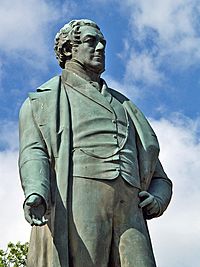Peel Memorial, Bury facts for kids
Quick facts for kids Peel Memorial |
|
|---|---|
 |
|
| Artist | Edward Hodges Baily |
| Year | 1851 |
| Location | Bury |
The Peel Memorial is a large public statue located in the town of Bury, Greater Manchester. It was created by Edward Hodges Baily, a famous British artist from the 1800s. Baily is also well-known for making the sculpture of Nelson on Nelson's Column in London.
This statue honors Sir Robert Peel, who was born in Bury. Sir Robert Peel was an important person in British history. He served as the UK Prime Minister twice. He also started the British Conservative Party.
The statue itself is made of bronze and stands 3.5 meters (about 11.5 feet) tall. It shows Sir Robert Peel wearing clothes from his time. He looks like he is giving a speech. The statue stands on a granite base that is 3.66 meters (about 12 feet) high.
The front of the base has the Peel family's special symbol, called a coat of arms. It also has the name "Peel" in big bronze letters. On the sides, there are bronze pictures that stick out, called bas-reliefs. These pictures show ideas like trade (Commerce) and travel by sea (Navigation). On the back of the base, there is a round bronze panel. It has a quote from one of Sir Robert Peel's speeches.
Originally, the statue had an iron fence around it. There were also gas lights at each corner. But this fence and the lights were taken away later on.
Contents
What the Inscription Says
A Message of Hope
The back of the statue's base has a special message. It is a quote from a speech Sir Robert Peel gave. He said these words when he stopped being Prime Minister on June 29, 1846.
The quote talks about how he hoped people would remember him kindly. Especially those who work hard every day. He wanted them to have "abundant and untaxed food." This meant food that was plentiful and cheap. He believed this food would taste "sweeter" because it was no longer made unfair by taxes. This shows he cared about helping working people get affordable food.
How the Statue Was Made
Remembering a Great Man
Sir Robert Peel died suddenly on July 2, 1850. Just eight days later, people in Bury had a meeting. They decided to build a monument in the town center. This would be a lasting way to remember their famous townsman.
A special group, called the Testimonial Committee, was formed. Their job was to raise money for the memorial. People were asked to donate money. In the end, they collected about £2,700. Most of this money, £2,500, was used for the statue itself. The rest covered other costs.
Nearly 2,000 people donated money. Some gave a lot, like Mr Thomas Norris, who gave £200. Others gave very little, like Miss Rachel Knowles, who gave just one penny. This shows how many people wanted to honor Sir Robert Peel.
Choosing the Artist
The committee decided the memorial should be a bronze statue on a granite base. Instead of having an open contest, they invited famous sculptors to send their ideas. Twenty-one artists were asked to take part. These included Edward Hodges Baily, who eventually got the job. Other well-known artists like Carlo Marochetti and John Henry Foley also sent ideas.
In February 1851, an exhibition was held at the town hall in Bury. People could come and see the different ideas from the artists. Many small statues, busts (head and shoulders sculptures), and building designs were on display. Over 14,000 people visited the exhibition in just a few days.
There was a rule that people wearing clogs (a type of wooden shoe) were not allowed in. But many working people in Bury were so excited to see the art. They even took off their clogs and ran up the steps in their socks! After looking at all the submissions, the committee chose Edward Hodges Baily for the job on February 14, 1851.
Creating the Bronze Statue
The statue was cast, or molded, at a place called Frederic Robinson and Edward Cottam's Statue Foundry. This was in Pimlico, London. They used a new method to make the statue. This allowed it to be cast as one single piece of bronze. People said it was "almost perfect from the mould itself." This meant it looked amazing right after it was made.
The Unveiling Ceremony
The finished statue was officially revealed on Wednesday, September 8, 1852. Many important people came to the ceremony. Sir Robert Peel's brothers, John and Lawrence, were there. His son, Frederick, who was a Member of Parliament for Bury at the time, also attended. Many local leaders were present too. A huge crowd of 10,000 to 15,000 local people gathered to see the new memorial.
The Peel Memorial is now a very important historical item. On January 29, 1985, it was named a Grade II listed building. This means it is a building or structure of special historical interest. A smaller model, called a maquette, that Baily made for the sculpture is kept at the Bury Art Museum.

